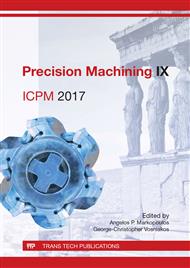p.129
p.135
p.143
p.151
p.159
p.167
p.173
p.181
p.189
Making Twist-Free Surfaces by Magnetic Assisted Ball Burnishing
Abstract:
As a well-known conventional finishing process, the grinding is commonly used to manufacture seal mating surfaces and bearing surfaces. It would lead to generate another finishing machining, which more cost-and energy-efficient, so the grinding process could be replaced by machining with roller burnishing or special type of polishing. The machined surfaces by turning or grinding usually have twist structure on the surfaces, which can convey lubricants such as conveyor screw. To avoid this phenomenon have to use special kind of techniques or machine, for example, rotation turning, tangential turning, ultrasonic protection or special toll geometries. All of these solutions have a high cost and difficult usability. In this paper, the authors describe a system and summarize the results of the experimental research carried out mainly in the field of Magnetic Abrasive Polishing (MAP) and Magnetic Roller Burnishing (MRB). These technologies are simple and also cheap while result the twist-free surfaces. During the tests, C45 normalized steel was used as workpiece material which was machined by simple and Wiper geometrical turning inserts in a CNC turning lathe. After the turning was used the MAP and MRB technologies to reduce the twist of surfaces. The evaluation was completed by advanced measuring and IT equipment.
Info:
Periodical:
Pages:
159-166
Citation:
Online since:
August 2017
Authors:
Keywords:
Price:
Сopyright:
© 2017 Trans Tech Publications Ltd. All Rights Reserved
Share:
Citation:


